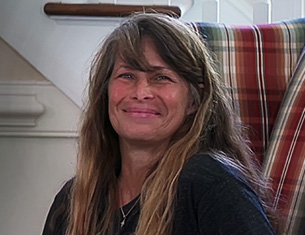Publisher's note: The author of this post is Dan Way, who is an associate editor for the Carolina Journal, John Hood Publisher.
ROBBINSVILLE
"I came here to make a living, not a killing," California native Dr. Patrick Kelley said from the basement workshop of his Graham County dentist office.
He and his daughter, Caroline Kemmerer, were putting the final touches on an assortment of amusement games they built for a fundraising carnival at Robbinsville High School for a local resident battling Stage 3 throat cancer. Kelley takes community volunteering seriously.
"I love this place. The people here are absolutely phenomenal. They're wonderful, wonderful people," Kelley said.
"Like this fundraiser that we're doing here. The whole county is getting together to raise money for people who have cancer."
Community cohesiveness, and a chance to give back, led him to establish roots in the Smoky Mountains, far from his northern California upbringing.
"When I came here 30 years ago there was not a dentist in the county. So we decided to open up here, and serve the community," Kelley said. The area is riddled with poor personal dental health practices and endemic poverty.
Kelley is an anomaly. Most doctors and dentists flock to larger population centers where it's easier to repay huge medical and dental school loans and financially sustain a practice.
Some North Carolina counties are in worse shape than Graham. State lawmakers are paying attention. On Thursday, June 7, the House passed
House Bill 998 in an in initial vote 107-0. Its provisions include a study of the dental-care shortage, with an interim report due Oct. 1, and a final report by Oct. 1, 2019.
The bill directs the state Department of Health and Human Services
"to identify the need for dentists in rural areas in North Carolina and to develop a recommendation to target loan repayment funds for dentists in rural areas that have been identified as having the greatest need for dentists." A final vote is scheduled for Monday.
Zulayka Santiago, program director of the North Carolina Oral Health Collaborative, thinks the loan repayment plan is just one piece of the solution.
"In addition to the shortage of dentists, there is a surplus of hygienists," Santiago said.
"It only makes sense to figure out ways to allow that work force to serve in those areas of high need."
A number of states allow hygienists to use the full range of their training in underserved areas, Santiago said.
But in North Carolina, scope of practice laws bar hygienists from working outside the direct supervision of dentists.
"This is an arena that gets very defensive very quickly," Santiago said of the dental profession's reaction to relaxing those restrictions.
"There is sort of a protectionist tendency in terms of making sure that their interests are put in the forefront," Santiago said.
"Unfortunately, the ripple effect of that is it harms North Carolinians who need access to care and aren't able to get it."
Hygienists with an independent rural practice could provide regular cleanings, place decay-preventing sealants on primary teeth, apply fluoride to prevent and arrest tooth decay, and identify health problems. They could be effective in elementary schools, long-term care facilities, and other settings in lower-income rural counties, Santiago said. That could save the state millions of dollars in preventable operating room costs.
The dentist shortage in parts of the state is real. When Kelley left California, most communities had a ratio of people to dentists of about 1,000:1, Kelley said. In North Carolina the ratio is 1,830:1, according to 2018 data from the University of Wisconsin Population Health Institute's County Health Rankings and Roadmaps report. In Graham County, it balloons to 4,280:1.
"Our closest endodontist is over an hour-and-a-half away [in Waynesville, Haywood County] if that tells you anything," Kemmerer said. She has a degree in health care administration, and moved to Orlando to work for a large corporate dental practice. The lure of the mountains where she grew up, and the desire to help her father, brought her back.
"An average dentist has about 2,000 active patients. Here we have over 7,000 active patients. So that's just the difference between an active Raleigh dentist to one here," Kemmerer said.
"You can just imagine the needs, and how much you have to be productive instead of popular."
"It's a pretty busy practice," Kelley says, showing off the six operation centers in the building where dental surgeries are performed with the latest equipment. Ralph Kurti, a part-time orthodontist, has been a partner for 20 years. There are two part-time dental hygienists, along with dental assistants and other staff members.
"We do a lot of big fillings, a lot of fillings, a lot of crowns, and we do a lot of partial dentures, and dentures," Kelley said.
"You have to be efficient. You have to multitask."
The only other dentist in the county is Rory Frederick, at the Graham County Department of Health. In addition to his private practice, Kelley started the Health Department clinic to serve children on Medicaid. He did that second job for 15 years, and helped to recruit Frederick. A dental hygienist and dental assistant also work at the Health Department, which is open four days a week.
N.C. Department of Commerce data for April 2018 show 20 percent of Graham County's population falls under the federal poverty line. Per capita income is $29,540, compared to $43,303 statewide. Twenty-one percent of adults are uninsured.
"We see private-pay patients. We see patients with insurance. We also take Medicaid," Kelley said.
"We have tailored our practice to fit the population, so we don't discriminate between those who have Medicaid and those who don't."
Medicaid covers about 40 percent of his costs, but he takes that in stride. In a more expensive place such as Raleigh, Medicaid might cover only 20 percent of dental practice's costs.
"We don't charge nearly as much as what you would charge in a big city because the population here can't afford $1,400, $1,200 for a crown," Kelley said. He charges $600 to $900 for crowns made by the same Charlotte company that makes the tooth covers for dentists statewide.
To help his patients save money, he does as many procedures as he can instead of referring them to higher-cost providers as most dentists would.
But he's still yanking lots of molars and bicuspids.
"I average extracting 1,000 teeth a year ... just due to decay, and people not coming a lot to the dentist," Kelley said.
"A lot of people will just call us up when their tooth is hurting, and then when I look at it, and assess it, really the only thing I can do is a root canal or extraction. Most people don't want to go to the expense of a root canal, so we end up pulling teeth."
Poor personal dental care isn't the only problem.
There is no fluoridated water, which helps to decrease the frequency of cavities, Kelley said.
"The elderly people have a lot of root decay because they take a lot of medications, and they're just prone to things like that," he said.
Despite the daunting impediments, Kelley is optimistic.
"We have changed the outlook of the dental health in the county over the last 30 years," he said, pausing and smiling.
"It's night and day compared to what it used to be."






















